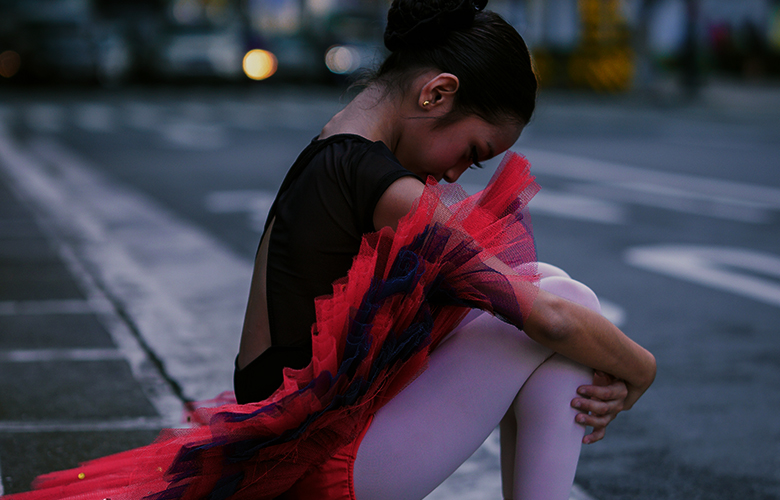
Being injured is an attack to a dancer’s motivation. Often cropping up at the most inconvenient times, injury is never easy to digest. With the potential to jeopardize a dancer both mentally and physically, injury is the thorn in a dancer’s side that we wish we didn’t have to deal with.
This would often spark hierarchical debates about who in the class had already ‘injured that’, or, ‘had it worse’. In fact, it became novel that someone would speak about an injury without someone else challenging it. It was an utterly unattainable competition.
An injury became a way of exemplifying how ceaselessly you had worked, or how ‘strong’ you had been in conquering it. When you encountered an injury, it was your moment of publicity: you’d instantly attract attention about what had happened, how serious your injury was and, crucially, whether you’d be able to dance again. Injury meant popularity.
Yet in the very same breath, injury was the mother of all inconveniences. One year, I stumbled into a tendonitis injury, just days before an annual showcase. I was rendered unable to dance. All I felt was an utter overwhelming of guilt – I had inconvenienced my peers, and it showed. Disappointed and pained, I would still constantly be asked ‘Is it that bad?’, ‘Can you dance anyway?’- I felt anything besides popular.
As teenagers, we simply didn’t understand the severity of injury and the impact that they often entail. Dance is characterised by its fierce infatuation with competition – as students, everything became a pursuit to be the best. There were no limitations on what could be made into a competition – mental health, eating and injury were all hot-topics of studio rivalry.
The issue is, from the minute we make the decision to pursue dancing, mantras of commitment and dedication are drilled into us from every angle. In dance, injury is often not treated with the correct weight – we guilt ourselves into thinking that everything is okay. And, like the industry as a whole, injury carries yet another means for competition.
It’s time that injury was given the correct attention.
As dancers, we often neglect ourselves. It’s not uncommon to stress about the impact your injury may have on others, above focusing on the complications that it may have on yourself. The first thing to understand is that injury is not your fault – nobody aims to get injured. Sure, you may face injury as a result of working too hard or practising unsafely, yet it’s never truly your fault that you incurred that injury. Stop believing that it is.
If a sprained ankle, torn ligament or stress-fractured foot means you can’t dance, don’t dance. Remember that shows, competitions and auditions come and go – missing one due to an injury is a smart move, not a reason to feel guilty. As dancers, we often like to ‘test’ an injury to see if we can still manage dancing, but this can only lead to consequences. Despite what your peers may say and regardless of how disappointed you may be, allow yourself to be injured. Allow yourself time-off, without feeling guilty.
If you mix artistic, intelligent and athletic people into one environment, you’re going to create unavoidable competition and this is exactly what the dance industry is like.
Dancers often struggle with self-esteem, meaning that they constantly need to validate their own success. This urge for constant competition seemingly filters into all aspects of dance, with the topic of injury included. But, never feel like you have to succumb to this.
Injury is personal, upsetting and unique to every individual. Medical severity of an injury does not determine how ‘upset’ a dancer may be about it – a dancer with a pulled muscle may be feeling just as low as a dancer with a broken ankle. Injury is not a quantifiable hindrance, so it should not be made into a competition.
Never feel like you have to rise to competition or prove to someone that your injury is worthy of feeling upset about. It does not matter if one of your peers has had a worse injury or whether they ‘dealt with it better’ than you. Injury is personal – you’re allowed to react to it in whichever way you decide.
A few years ago, I developed a knee injury, which eventually forced me to take six months away from dance. It was the type of injury that was only painful when I actually danced – simply walking or moving around gave me next to no discomfort. However, I became aware that I had to make my injury visible for others to believe me – I felt like I had to walk around with a limp just to prove to people that I was actually injured. After all, if they couldn’t physically see that I was injured, how would they believe me?
I’ve seen similar things to this recently: dancers wrapping up their limbs with tape, unnecessarily, just so that their peers can ‘see’ that they are injured.
The truth is, the only person concerned about your injury is you. Realistically, your peers won’t worry about your injuries – they won’t even think about them. Having invisible injuries is absolutely okay – you never need to exemplify that your injury is really there.
Undoubtedly, injuries are often the result of working hard – and what’s more admired than that?
However, you must remember that an injury is often a side-effect of working incorrectly. Injury is never an excuse to show-off about how committed you are or how admirable you are for battling it.
Sapping away at our well-being, injury can be a cause for great sensitivity, so it’s a subject that you have to tread through delicately. Boasting about your previous injuries may hit a nerve in any one of your peers or teachers – so find something better to brag about.

Stay or Play? The Difference Between Setbacks and Shutdowns
Perfectionism: A Dancing Crisis


Mia Lyndon is a UK based freelance writer, who has previously trained as a contemporary dancer. She is the creator and director of Audition Quest (auditionquest.co.uk), an online audition support enterprise. Mia has written and edited for numerous platforms, including online magazines and dance & theatre websites. She is also a guest blogger for a variety of dance and performing arts blogs. CONTACT: auditionquest@gmail.com
Read Full Profile© 2021 TheatreArtLife. All rights reserved.

Thank you so much for reading, but you have now reached your free article limit for this month.
Our contributors are currently writing more articles for you to enjoy.
To keep reading, all you have to do is become a subscriber and then you can read unlimited articles anytime.
Your investment will help us continue to ignite connections across the globe in live entertainment and build this community for industry professionals.